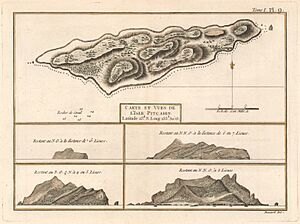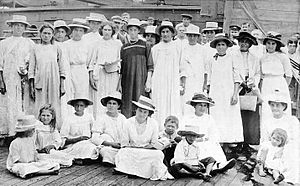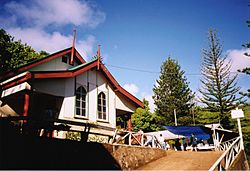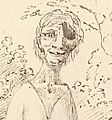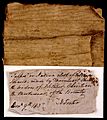Pitcairn Islanders facts for kids
| Total population | |
|---|---|
| 800-1,000 worldwide | |
| Regions with significant populations | |
| 47 (2021) | |
| 484 (2016) | |
| 262 (2016) | |
| 48 (2018 birthplace) | |
| Languages | |
|
|
| Religion | |
| Seventh-day Adventist Church | |
| Related ethnic groups | |
|
|
Pitcairn Islanders, also known as Pitkerners, are the people who live on the Pitcairn Islands. These islands are a British Overseas Territory. Many Pitcairn Islanders are descendants of the famous Bounty mutineers. Their culture is a mix of British (from England, Cornwall, the Isle of Man, and Scotland) and Polynesian (from Tahiti).
The first settlers arrived in 1790. As of 2021, only 47 people live on the main island. However, many Pitcairn Islanders also live in other places. Large groups live in Norfolk Island, New Zealand, and Australia. In 1856, almost all 194 Pitkerners moved to Norfolk Island because they worried about overcrowding. But later, some families decided to return to Pitcairn.
Contents
History of Pitcairn Island
How Pitcairn Island Was Found
Pitcairn Island was first seen on July 3, 1767. This happened when the British ship HMS Swallow sailed by. Captain Philip Carteret was in charge of the ship. The island was named after a young crew member, 15-year-old Midshipman Robert Pitcairn. He was the first person to spot the island.
The First Settlers Arrive
In 1790, a group of people settled on Pitcairn Island. This group included nine mutineers from the ship Bounty. They were joined by six Tahitian men, eleven Tahitian women, and a baby girl. They burned the Bounty ship after they arrived. You can still see the wreck of the Bounty underwater in Bounty Bay today.
Life was hard at first, but the settlers survived by farming and fishing. Over time, two of the leaders, John Adams and Ned Young, used the ship's Bible to help create a peaceful society. After Pitcairn was rediscovered, John Adams was forgiven for his part in the mutiny.
Pitcairn's Changing Population
The number of people living on Pitcairn Island has changed a lot over time.
- In 1790, there were 27 people.
- The population grew to its highest point of 250 people in 1936.
- In 1856, almost everyone moved to Norfolk Island, leaving Pitcairn empty for a short time.
- By 1859, the first group of people returned, and the population was only 16.
- Today, the population is much smaller, with 47 people in 2021.
Family Names on the Island
Most of the family names on Pitcairn Island come from the six families who returned from Norfolk Island starting in 1859. Sometimes, new people arrived and brought new surnames. For example, the American Samuel Russell Warren had children whose descendants still live on the island. The McCoy family name, from mutineer William McCoy, ended in 1973.
Here are some of the main family names on Pitcairn Island in 2016:
| List of surnames in 2016 | ||||
|---|---|---|---|---|
| Rank | Surname | Population | Origins | |
| 1 | Christian | 15 | Manx, English | |
| 2 | Warren | 10 | English | |
| 3 | Warren-Peu | 6 | English-Polynesian | |
| 4 | Brown | 4 | English | |
| 5 | Young | 3 | Manx, English | |
| 6 | Lupton-Christian | 2 | Manx, English | |
| 6 | Griffiths | 2 | Welsh | |
| 7 | Evans | 1 | Welsh | |
| 7 | Jaques | 1 | French | |
| 7 | Menzies | 1 | Scottish | |
| 7 | O'Keefe | 1 | Irish | |
| 7 | Peu | 1 | Polynesian | |
Pitcairn Island Culture
The rules about what people could do on the island used to be very strict. For example, dancing and smoking were not allowed. These rules have become less strict in recent years. Now, islanders and visitors can buy and use alcohol without needing a special permit. There is even a licensed cafe and bar on the island.
Fishing and swimming are popular ways to have fun. When there's a birthday or a ship arrives, the whole community gathers for a big public dinner. They set up tables in the main square in Adamstown. Everyone brings different foods like fish, meat, chicken, baked rice, bananas, breadfruit, and many kinds of desserts.
People on the island also work together to keep the roads and paths in good condition. In 2011, there were over 35 men and women working to maintain the island.
Language Spoken on Pitcairn
Most Pitcairn Islanders are descendants of the Bounty mutineers and Tahitians. They speak a special language called Pitkern. This language is a mix of 18th-century English and the Tahitian language. Pitkern is the first language for most people on the island. It is also taught alongside standard English at the island's only school. Pitkern is very similar to Norfuk, a language spoken on Norfolk Island. This is because Pitcairners moved to Norfolk Island in the mid-1800s.
Religion on Pitcairn
Everyone on Pitcairn Island belongs to the Seventh-day Adventist Church. This church became very important in shaping Pitcairn society after a successful mission in the 1890s. In recent years, fewer islanders attend church regularly. However, most still go to church for special events. The Sabbath (Saturday) is observed as a day of rest to show respect for the Adventist faith.
The church building was built in 1954. It is managed by a church board and a pastor who usually stays for two years. On Saturday mornings, there is a Sabbath School at 10 AM, followed by a church service. On Tuesday evenings, there is also a prayer meeting.
Pitcairn Islanders Around the World
Many Pitcairn Islanders and their descendants live outside the Pitcairn Islands. This is called a diaspora.
Pitcairners in Australia
In 2016, the Australian census showed that 746 people had Pitcairn ancestry. This number includes those living on Norfolk Island. About 262 people of Pitcairn ancestry lived in other parts of Australia, especially in Queensland and New South Wales.
In 2011, 75 people in Australia said they spoke the Pitkern language at home. This was an increase from 62 people in 2006.
Norfolk Island Community
Norfolk Island has a large community of people with Pitcairn ancestry. The 2016 census showed that 20% of the people on Norfolk Island (484 people) claimed Pitcairn ancestry. Many of these descendants are now 7th, 8th, or even 9th generation. This means their connection to the original Pitcairn heritage is naturally becoming less strong over time.
Pitcairners in New Zealand
In 2018, 48 people living in New Zealand were born on Pitcairn Island. In 2013, the Pitcairn Islander ethnic group in New Zealand included 177 people. Most of them (80.7%) were born in New Zealand. The population of this group decreased by 13.4% between 2006 and 2013.
- Most Pitcairn Islanders in New Zealand (96.6%) live on the North Island.
- The most common area for them is the Wellington Region (59.3%).
- The average age for this group was 37.2 years.
- About 27.1% of them said Pitcairn Islander was their only ethnic background. Many others said they belonged to two or more ethnic groups.
Notable Pitcairn Islanders
Notable Pitcairners in the Diaspora
See also
- Bibliography of Pitcairn Islands
- Europeans in Oceania
- Island Council (Pitcairn)
- Law enforcement in the Pitcairn Islands
- Norfolk Islanders
- Outline of the Pitcairn Islands


